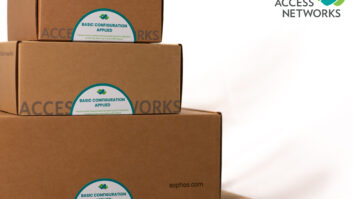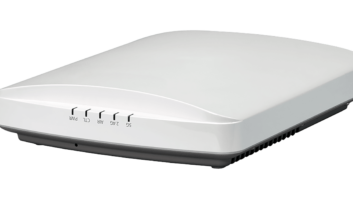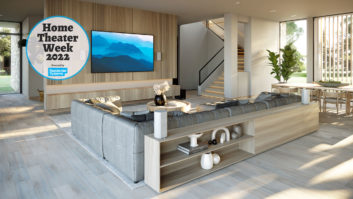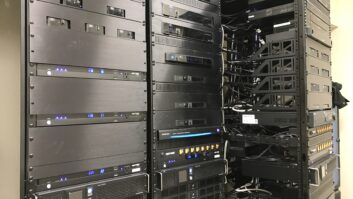Pop quiz: assuming you’re familiar with Access Networks (and you should be), can you explain exactly what it is that the company does? If your answer is, “Networking something-or-other, right?” you’re in good company. That was pretty much the extent of my understanding when Hagai Feiner, the company’s founder and CEO, and Sarah Fleishman, director of marketing, approached me at a conference in March and asked if I would like to review an Access Networks system.
“Sure!” I said on the outside. “What the heck did I just agree to?” I thought on the inside.
The first step on the road to acquiring an Access Networks system for my home involved submitting a floor plan (in PDF format), complete with a questionnaire about construction materials, climate control, wiring constraints, equipment locations, control system specifics, the presence of Kaleidescape servers or VoIP phones, whether I wanted outdoor Wi-Fi coverage, the location (or lack thereof) of outbuildings, and a number of other details specific to the goal of designing a robust network specifically for the smart, connected home.
Given my previous life as a civil engineer, drawing the floor plan was no problem, but just out of curiosity I asked how custom integrators who weren’t CAD-equipped former draftsmen might provide such a file. Most, it turns out, use D-Tools. Others sketch and scan. In some extreme cases, the gurus at Access Networks will actually pull up a Google Maps view of the home, trace the outline, and walk the integrator through the home over the phone to concoct some semblance of a floor plan.


The author’s Access Networks home network includes a Cisco enterprise-grade router and Ethernet switches, a Ruckus Zone Director, and wireless access points.
At any rate, with the floor plan submitted and all of the pertinent questions answered, my next step was to wait for a proposal. Two, in fact. Sales manager Bryce Nordstrand soon contacted me with two potential equipment lists, complete with pricing, that included some names I was already familiar with and a few that I wasn’t: a Cisco enterprise-grade router and Ethernet switches; Ruckus Zone Director and wireless access points. I’m not really supposed to talk about pricing here, but I think I can get away with saying that I Googled the equipment list and quickly discovered that the price at the bottom of both invoices was pretty much in line with what I would spend if I went out and bought the equipment myself. And that’s not counting the hours I would waste deciding what to buy, much less the time it would take to configure it all.
After a few minutes of discussion, we both agreed that we could get the cost of the system down a little by replacing the PoE switches with non-PoE versions and using injectors selectively where needed. And with that, I only had to fill out one more form that allowed to me tweak Gateway, Subnet Mask, and DNS Server information if I wanted to (I did, since I was replacing an existing network and almost all of my components are assigned static IP addresses), and set up Wi-Fi networks and passwords. Honestly, at this point, the process seemed a little too simple to me, so I started asking tons of questions in the vein of, “But what about…?” “But how do I…?” “But what if I need to…?” The words, “Dude, chill, we’ve got this,” were never actually uttered, but that was the subtle message I picked up on. So I sat back and waited for the networking equipment to arrive. Boxes and boxes and more boxes of networking equipment. Thankfully, one of those boxes was affixed with a big green sticker that read, “Start here,” inside of which was a complete map of which component went where in my home, exactly where to place the wireless access points, and which wires connected to which ports on which boxes. Seriously, I’ve seen shampoo bottles whose directions were harder to follow. And yet, despite all of that, despite my entire experience with Access Networks thus far, I still looked at all of those plugged-in cables and flashing lights, cracked my knuckles, and said to myself, “Now for the hard part.”

The author took his iPhone 5S to the back of his yard and ran a speed test to gauge the beamforming capabilities of Access Networks’ wireless access points. The results? An impressive 24.1mbps down and 4.82mbps up. Spoiler alert: there wasn’t a hard part. I was done. There was nothing to configure. No settings to tweak. No QoS settings to set. No Wi-Fi channels to select (the Ruckus WAPs actually channel-hop almost instantly at the slightest hint of a signal interference).
The only thing left for me to do was put the system to the test, which I did by firing up my Roku Stick in the home theater and queuing up some Amazon Instant Video. I have a relatively decent internet connection (for my area, at least), with 30mbps download speeds and 5mbps upload speeds. Yet, in the past, by the time that signal got to my Roku, it was diminished to the point where videos would pause and queue every five or ten minutes before eventually dropping down to standard-def. I watched an entire episode of Sherlock with the new Access Networks system in place, and never once did it pause, stutter, or drop below the maximum quality. I also tried some 4K Ultra HD Netflix via the Samsung UHD TV currently in the media room, which was a bust with my old consumer-grade router. It flowed like water.
Over the next few days I noticed something else. My Control4 system, which in the past would occasionally take a few seconds to respond, was much peppier and easier to wake up. Just for giggles, I took my iPhone 5S to the back of my yard and ran a speed test to gauge the beamforming capabilities of the wireless access points. The results? An impressive 24.1mbps down and 4.82mbps up. I’ve also noticed a lot less profanity coming from my wife, who primarily uses Wi-Fi to check work emails on her phone.
If I had one complaint about the Access Networks system I received, it was that the 24-port Ethernet switch in the home theater was loud. Really loud. Despite being mounted inside my enclosed OmniMount RE27 rack, I could still hear it from the other side of the house when the air conditioner wasn’t running. I brought this up and shortly thereafter Access Networks replaced that noisy switch with two smaller, passively cooled Gigabit switches. After that change, I honestly didn’t think about the network much at all, until it came time to write this review. It’s now as quiet as it is invisible. It never needs maintenance. It simply works.
310.453.1800
www.accessca.com
Kudos
If you still haven’t wrapped your brain around what Access Networks does, essentially they take the guesswork out of enterprise-grade networking design, they take the hassle out of network setup, they make the installation process so easy that your mom could do it, and they do it for not much more money than you would spend buying the same gear yourself.
Concerns
This isn’t a reflection on Access Networks, of course, but enterprise-grade networking solutions take up a good bit of rack space, and selling your clients on the cost might not be the easiest thing in the world.







